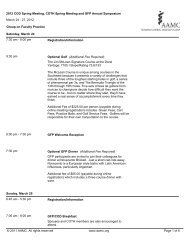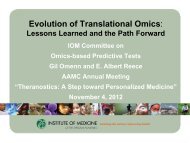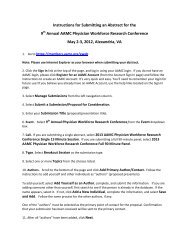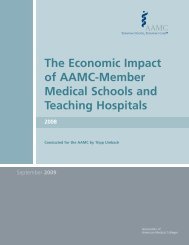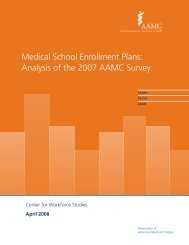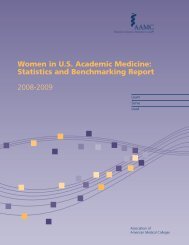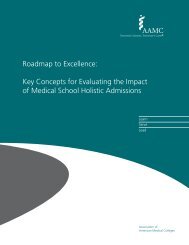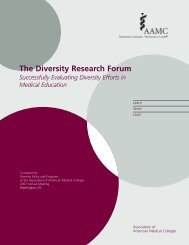Roadmap to Residency: - AAMC
Roadmap to Residency: - AAMC
Roadmap to Residency: - AAMC
You also want an ePaper? Increase the reach of your titles
YUMPU automatically turns print PDFs into web optimized ePapers that Google loves.
<strong>Roadmap</strong> <strong>to</strong> <strong>Residency</strong>: FromApplication <strong>to</strong> the Match and BeyondIV. <strong>Residency</strong> Program Selection Criteria<strong>Residency</strong> applicants should be knowledgeableabout the path for training in achosen specialty, as well as about thepersonal criteria they will employ inselecting a residency program.A. Understanding the trainingpath for the chosen specialtyInformation about the training paths formany specialties and subspecialties isavailable on the Careers in Medicine Website (www.aamc.org/students/cim/specialties.htm). The Graduate MedicalEducation Direc<strong>to</strong>ry (the “Green Book”)published annually by the AmericanMedical Association (www.amaassn.org/ama/pub/category/3991.html)also lists contact information for 8,250ACGME-accredited and combinedspecialty programs and 1,700 graduatemedical education teaching institutions,data for and descriptions of all specialtiesand subspecialties, and American Boardof Medical Specialties medical specialtyboard certification requirements. Anotherkey AMA resource is FREIDA Online®(Fellowship and <strong>Residency</strong> ElectronicInteractive Database Access, www.amaassn.org/go/freida),an online databasecontaining information on 8,200+graduate medical education programsaccredited by the ACGME, as well as on200+ combined specialty programs.FREIDA permits comparison of specialtieson such fac<strong>to</strong>rs as length of training,program size, number of faculty, work andeducational environments, and compensation,as well as on the career plans ofgraduates from various specialties asreported by their program direc<strong>to</strong>rs.B. <strong>Residency</strong> program selectioncriteria<strong>Residency</strong> applicants should consider inadvance the criteria by which they willinitially assess programs <strong>to</strong> determinehow many and <strong>to</strong> which programs theywill make application, as well as <strong>to</strong>determine, after visiting programs atwhich they have been invited <strong>to</strong>interview, those programs that they willplace on their rank order list (ROL). Atleast three different types of criteria canbe employed in this process: those aboutthe nature and quality of the educationalprogram, those based on personal preferencesand needs, and those based onresidency agreement and stipend issues.• Program issues:a. Morale of current residents (lookfor satisfied residents)b. Current accreditation statusc. Program qualityd. Program sizee. Educational structure: requiredrotations, formal curriculum,informal learning opportunities,support systemsf. Clinical responsibilities: callschedule, supervisory structure,ancillary supportg. Opportunities for research andteachingh. Evaluation processes: timing andstructure of resident evaluationi. Program type: academic orcommunity; hospital-based orambula<strong>to</strong>ryj. Opportunities for interaction withresidents in other residency trainingprogramsk. Reputation of program direc<strong>to</strong>rand faculty membersl. Success of graduates in obtainingfellowships.• Personal issues:a. Locationb. Housingc. Cost of livingd. Proximity <strong>to</strong> family memberse. Spousal and family opportunities.• <strong>Residency</strong> agreement and stipendissues:a. Stipendb. Leave: vacation, sick, andprofessionalc. Benefits: health, liability, anddisability insurance (including datesof initial coverage for newresidents)d. Other prerequisites.6Association of American Medical Colleges, 2005



